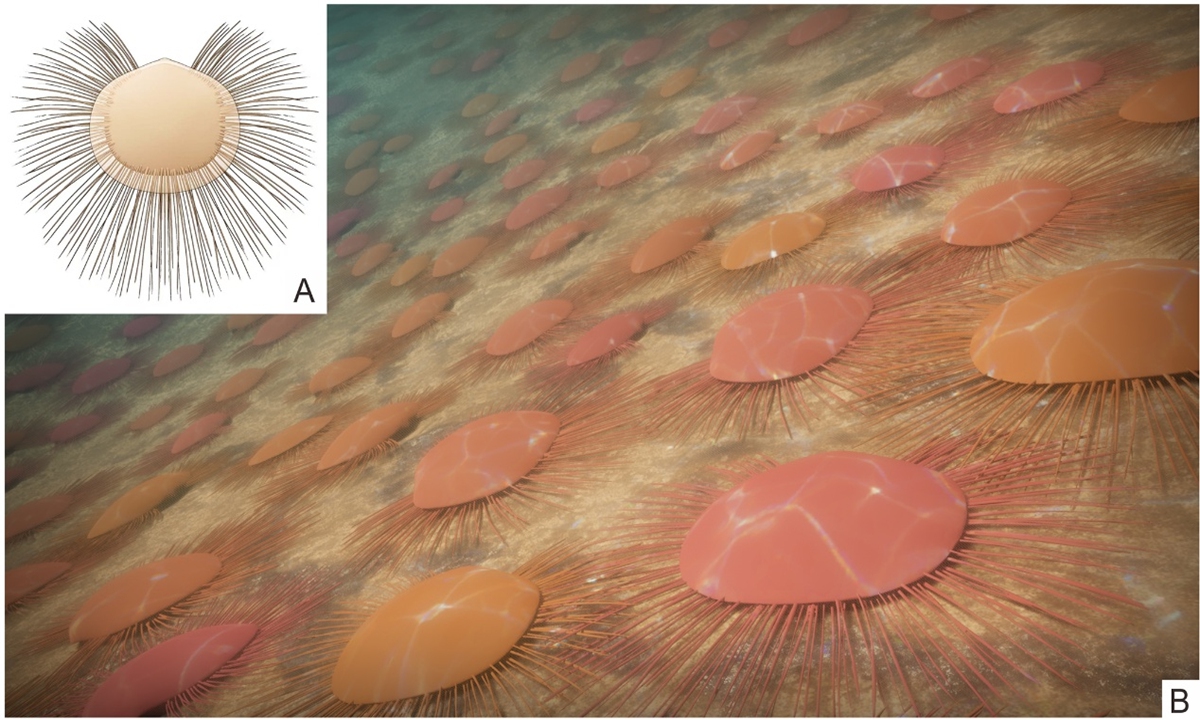Nucleospira calypta Photos: CCTV News
Chinese scientists’ latest findings in ancient seabed community illustrate a biological mechanism capable of shaping community structure, operating beyond passive environmental constraints or initial larval settlement preferences, and highlight the potential for subtle anatomical features to exert significant ecological influence in deep time, according to a research article published on Monday by the Proceedings of the National Academy of Sciences of the United States of America (PNAS), a leading scientific journal in the world.
Huang Bing and Rong Jiayu, research fellows from the Nanjing Institute of Geology and Paleontology of the Chinese Academy of Sciences, cracked the mystery of social distancing by reporting exceptionally preserved soft, bristle-like structures (“setae”) on 436-million-year-old brachiopods, enabling the analysis of ancient behavior.
The research team worked on the 436-million-year-old early Silurian brachiopod fossil community discovered in Tongzi and Renhuai, Southwest China’s Guizhou Province. For the first time, Huang and Rong identified a regular, checkerboard-like spacing pattern among these organisms, closely corresponding to their setae length. This demonstrates that these delicate structures played an important role in maintaining spacing between individuals, thereby influencing community organization on the ancient seabed.
Their findings point to a previously unrecognized mechanism shaping ecosystem structure in deep time, demonstrating how subtle anatomical features could have exerted notable ecological impacts in their ancient environments.

Nucleospira calypta
The study focused on Nucleospira calypta. The fossil specimens buried in situ in this study completely preserved their true state at the last moment of their lives, opening a precious window for scientists to observe ancient biological communities.
Setae are slender, flexible, hair-like structures growing on the edge of their mantles. They are extremely difficult to preserve in fossils, especially in the long geological history after the Cambrian period, approximately 541 million years ago. The specimens studied this time also rarely preserve the setae structure on the edge of the mantle of brachiopods.
Through a variety of modern analytical techniques, the researchers not only clearly reconstructed the fine morphology of these setae with a diameter of about 20 microns but also confirmed one of the unique preservation mechanisms: the setae first rapidly pyritized in an oxygen-deficient environment and then were coated with a calcium shell in weakly acidic conditions to prevent compaction and oxidation. Therefore, even if the pyrite later converted into iron oxide, its microscopic morphology was still preserved perfectly.
After the confirmation of the fine structures, the researchers focused on the layout of the entire community. Through analysis, they found that the distribution of these brachiopods was not random and chaotic, but presented a statistically significant, non-random, uniform distribution pattern that looks like a chessboard. This “chessboard-like” layout indicates that there is a mechanism between individuals.
How was this precise spacing adjustment achieved?
Through analysis, the researchers found that there is a clear quantitative relationship between the average distance between individuals in the fossil community and the length of their well-preserved setae. This kind of fine-tuning of position in seemingly immobile organisms is not without precedent. For example, modern Cirripedia can still migrate extremely slowly after being fixed to optimize their living space.
When individuals are too close to each other, their extended setae will reach their neighbors. This continuous physical contact, after a long period of accumulation, eventually leads the entire population to a stable configuration where no interference is caused and space utilization is optimized. “This is crucial for filter-feeding organisms to minimize interference with each other’s feeding water flow,” said Huang in an interview with the Nanjing Daily.
For the first time, the study directly links a subtle anatomical structure (setae) with a statistically significant spatial pattern of community, providing direct fossil evidence for the core question of paleoecology: “How do interactions between organisms shape distribution structure?” This shows that the formation of ancient communities was not only subject to passive environmental factors or the random fixation of larvae, but also that interactions between individual organisms caused by their morphological structures played a crucial role. This discovery not only deepens the understanding of the complexity of Paleozoic marine ecosystems, but also highlights the important ecological impacts that seemingly insignificant features may have in the process of evolution.
Global Times